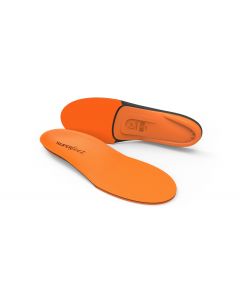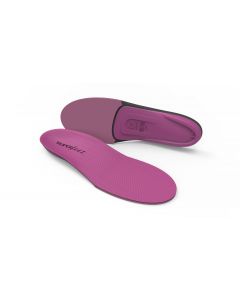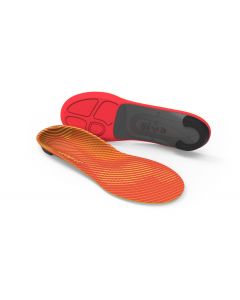
Written with contributions from Superfeet Wellness Experts and the Superfeet education team.
You may not know what a flat foot is, but judging from the way the term is used, you know you don't want one. Being caught flat-footed is a negative term implying you can't react quickly. Of course, that perception is wrong.
People with flat feet may feel that their feet are abnormal, but that's simply not true. Everyone's foot is different, and if yours are on the flattish side, you can take steps to relieve any pain or discomfort that you may be experiencing.
What are flat feet?
Flat feet, or fallen arches, occur when the arch, the curved part of the sole of your foot, is low or absent, leading to the entire sole coming close to or touching the ground. This condition can be inherited or develop from various factors such as injury, obesity, aging, and specific medical conditions. While some people with flat feet experience no issues, others might face pain and discomfort, necessitating support through orthotics or specialized footwear to mitigate symptoms and improve foot function.
How do you know if you have flat feet?
To determine if you have flat feet, observe the arch of your foot while standing. If the arch flattens, allowing the entire sole to touch the ground, you likely have flat feet. Additionally, symptoms like foot pain, particularly in the arch or heel, can indicate this condition. For a comprehensive understanding, consider consulting a healthcare professional.
Can flat feet be fixed?
While flat feet can be a permanent condition for many, there are ways to manage and potentially reduce the discomfort associated with it. Treatments can include physical therapy, exercises to strengthen foot muscles, wearing supportive shoes and orthotics designed for flat feet, and in some cases, surgical intervention for severe issues. These methods aim to improve foot function, reduce pain, and enhance quality of life rather than "fixing" the flat arch itself. For a comprehensive understanding of managing flat feet, consulting a healthcare professional is recommended.
What causes feet to go flat?
The shape of your feet is determined, for the most part, by your genes. Most people have flat feet as small children as the internal structure of the foot has not fully developed. As people age, many people form a visible contour in the middle of their feet. Others do not. Either situation is considered normal.
You may have a visible arch and lose it as you age for a number of reasons. You could have acute injury to the arch of your foot. Being overweight can put excess pressure on your foot, which may cause flat feet. Simple aging is also an issue as your arches can flatten over time. Diseases like rheumatoid arthritis and diabetes can also be factors in this condition.
In short, feet can go flat for a variety of reasons including genetics, aging, injury, obesity, and certain medical conditions. These factors can lead to the weakening of the arch, resulting in flat feet.
Superfeet help for flat feet
The orthotic, supportive shape of Superfeet shoe inserts provide the structure and cushion your flat feet crave, and can combat the aches and fatigue caused by standing and walking on hard surfaces.
Which Superfeet will work best for flat feet?
To find the right Superfeet, start with your shoes. What type of shoes are you wearing? What you are doing in those shoes? We think you deserve to experience the I-never-knew-my-feet-could-feel-this-good benefits of the Superfeet shape in all your footwear. That’s why we make insoles for casual and dress shoes, shoe inserts for high heels, insoles for hiking, insoles for running shoes, insoles for snow sports, insoles for skates, and more. Need help finding the best Superfeet for you? Take the online insole finder quiz.





